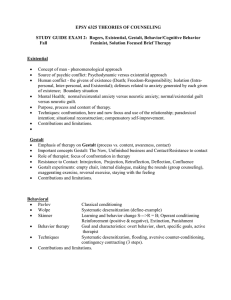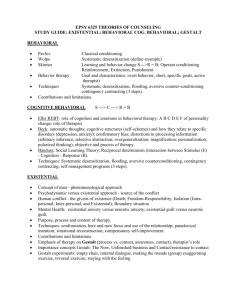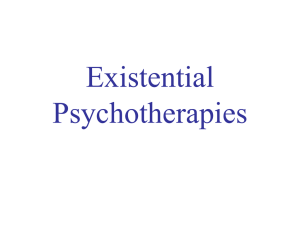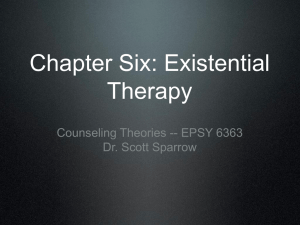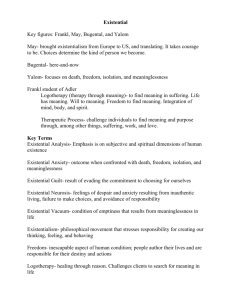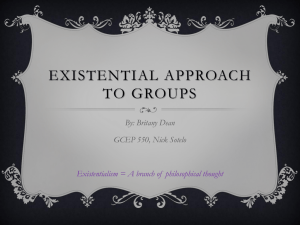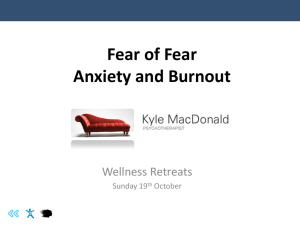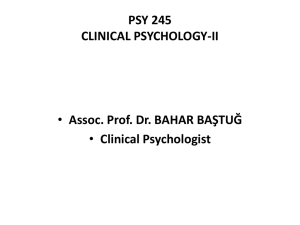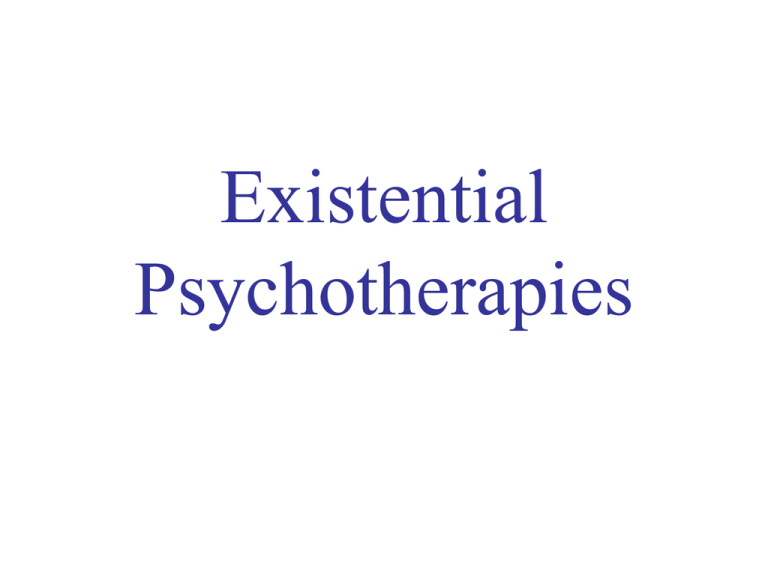
Existential
Psychotherapies
EXISTENTIAL APPROACHES
Way of thinking about humans and about life that
may be applied to other psychotherapy approaches
Closely linked to European Existential Philosophy:
Dilemmas of contemporary life (1940-50s)
isolation, alienation and meaninglessness
Importance of subjectivity – we create our values, our
lives, ourselves
Truth depends on the existing person, in a given
situation and in a given time
Freedom to be ourselves implies responsibility
2
European Existential Philosophers
Kierkergard
angst - dread and anxiety related to uncertainty in living
Nietzsche
Values are within the individual
Sartre
Freedom to be what we choose and related responsibility
Simon de Beauvoir The Second Sex
Buber
Stressed the I/Thou Relationship – less individualistic
Biswanger
existential analyst, emphasized subjective and spiritual
dimensions
3
Existential Psychology
Victor Frankle
Logotherapy Man in Search for Meaning
Nietzsche “He who has a why to live for, can bear
with almost any how.”
Rollo May
Co-editor : Existence: A New Dimension in
Psychiatry and Psychology (1958) introduced
existential psychology to the US.
Irving Yalom
Existential Psychotherapy
4
Basic Dimensions of the Human
Condition
Capacity for self-awareness
Freedom and responsibility
Creating one’s identity and meaningful
relationships with others
Search for meaning, purposes, values
and goals
Anxiety as a condition for living
Awareness of death and non-being
5
Theory of Personality
Dynamic Model
Forces in conflict
need to survive and assert one’s being vs.
conscious and unconscious fears related to:
Givens of Existence or Ultimate Concerns
Death
Freedom
Isolation
Meaninglessness
6
Conflict/Mental Health
Awareness of Ult. Concerns
>>>Anxiety >>> Def. Mechanisms
Ways to deal with the anxiety
Provide safety, restrict growth
Mental Health
Ability to cope with normal anxiety
7
Anxiety
NORMAL ANXIETY
Proportionate to the situation
Does not require repression
Can be used creatively
NEUROTIC ANXIETY
Disproportionate to the situation
Tends to be repressed
Paralyzes the individual
8
Guilt
Normal
Ethical aspects of behavior
Neurotic
Fantasized transgressions
toward others, or failure to live
up to one’s capacities
9
Objective of Therapy
Explore anxiety related to the ultimate
concerns, concious/unconscious
Identify mechanisms of defense (symptoms)
clients use to deal with existential anxiety
Move clients to confront the fear and the
pain associated with the ultimate concerns
Help clients develop adaptive ways of dealing
with existential anxiety
10
Freedom vs. Responsibility
We are ultimately responsible for who we
are, what we believe in, and how we
behave
We must make authentic choices rather
than follow what has been given to us
Anxiety is generated by our fear of not
knowing or of making mistakes
11
Responsibility: Defenses
Displace it
others/circumstances
Deny responsibility
e.g. victim role
Avoid responsibility
e.g. symptoms
12
Process of Making Decisions
WISHING >>>> WILLING >>>> ACTION
Symptoms
Impulsive Behavior
Non-discrimination among wishes
Compulsive Behavior
Driven by ego-alien demands
13
Freedom:Therapy
Help client recognize and accept
responsibility for making choices
Confront responsibility avoidance
(won’t vs. can’t)
Encourage clients to connect with their
feelings
Explore how client contributes to
problem situation
14
Isolation
Awareness of our intrinsic isolation vs.
desire to be part of something larger
Interpersonal
social skills, intimacy
Intra-personal connected with self
Existential
Unavoidable
Defense:
Fusion: soften our ego boundaries and
become part of another individual, group,
or cause
15
Isolation: Therapy
Help clients confront their fear of aloneness
Personal growth entails a degree of isolation
To create authentic relationships with others we
must have confronted and accepted our
ultimate isolation
Within the real relationship between client and
therapist, client may learn limits and rewards
of intimacy
16
Meaninglessness
We naturally search for meaning, but we
live in a world where there are no intrinsic
meanings
Need to construct a personal sense of meaning
“Wishing” Source of meaning require access to
affective experience
Meaning is usually found when we look beyond
ourselves and meeting our material needs.
A sense of meaning is related to our values that
tell us why we live and how to live
17
Meaninglessness: Therapy
May not be an issue for all clients
Personal growth
Boundary situations
Depression
Help clients connect with their affective
selves, to discover inner sources of motivation
and meaning
Help clients get engaged in life activities
18
Boundary situation
Experience or event that propels the person to
face an existential situation related to any of
the ultimate concerns:
terminal illness
death of a loved one
life crisis
life change
19
Death
Fear of self-destruction – primary source of
anxiety
Defenses against death awareness – denial,
reaction formation
Awareness of death gives meaning to our
life
enhances the importance of the present
moment
leads us to live more fully
20
Defense Mechanisms
Awareness of Ult. Concerns >>>Anxiety
>>> Def. Mechanisms
Drive >>> Anxiety >>> Def. Mechanism
Defense mechanisms provide some temporary
relief, but they restrict growth
Existentialists ascribe to the defense
mechanisms that were proposed by Freud
21
Psychotherapy : Goals
Main goal is to help clients
increase awareness about themselves and
how they are living
confront their anxieties and fears
re-define themselves and their world in ways
that lead to a more authentic life
Main vehicle of therapy is an authentic,
real relationship with therapist
22
Psychotherapy: Relationship 1/2
Therapy is a journey taken by therapist and
client
The person-to-person relationship is key
Therapist stays in contact with their own
phenomenological world
Therapist must distinguish between transference
and the actual, real relationship (they co-exist)
23
Psychotherapy: Relationship
The core of the therapeutic relationship
Respect and faith in the clients’ potential to cope
Sharing reactions with genuine concern and
empathy
Focus on the here-and-now experience in the
therapeutic relationship
24
Psychotherapy: Techniques
Paradoxical intention
prescribing the symptom: help clients gain more
control of their behavior, get “unstuck”
Situational reconstruction
think of three ways in which a situation could be
better and three ways in which it could be worse to help people move on from the place they are
stuck
Compensatory self improvement
work on areas that you have control when you are
in a situation you don't control
25
Contributions
Provides new dimensions to the
understanding of death, anxiety, guilt,
loneliness, and alienation
Emphasizes the person's freedom and
responsibility in designing their own
lives
Importance placed on the human quality
of the therapeutic relationship
26
Contributions
Philosophical orientation applicable
regardless of counselor’s theoretical
orientation
Particularly useful to understand issues
presented by clients who may be
confronting existential crises
27
Limitations
Lacks a systematic statement about
principles and practices of
psychotherapy
Does not lend itself to empirical
research
Concepts are abstract and difficult to
apply in practice
28
Gestalt
Existential & Phenomenological – it is
grounded in the client’s “here and now”
Initial goal is for clients to gain awareness of
what they are experiencing and doing now
Promotes direct experiencing rather than the
abstractness of talking about situations
Rather than talk about a childhood trauma the client
is encouraged to become the hurt child
29
Frederick Perls 1893-1970
Born in Germany,
Psychiatrist and psychoanalyst
Emigrated to U.S. in 1946 and broke form
psychoanalytic tradition
Controversial and charismatic figure
Gestalt therapy became a kind of cult
Collaborated with his wife (Laura Perls 19051990) in delivering workshops and writing
30
The Now
Our “power is in the present”
Nothing exists except the “now”
The past is gone and the future has not yet arrived
The power of the present is lost if :
We focus on past mistakes or engage in endless
resolutions and plans for the future
Therapist focuses more on the process of therapy
than on the content
31
Unfinished Business
Unexpressed feelings such as anger,
resentment, and fear that are:
Threatening
Not fully experienced in awareness
Interfere with effective contact with oneself and
with others
Result:
Preoccupation, compulsive behavior, wariness
oppressive energy and self-defeating behavior
32
Contact and Resistance to Contact
CONTACT
To interact with environment w/o losing one’s
individuality
Requires awareness, energy and ability to express
oneself
RESISTANCE TO CONTACT
Defenses that prevent experiencing the present fully
There are five major channels of resistance to attempt
to control the environment rather than allowing real
contact
Typically are out of awareness; may contribute to
dysfunctional behavior
33
Defenses
Resistance to Contact
Introjection
Uncritical acceptance of others’ beliefs and
standards w/o making them our own.
• Lack of clear sense of self
Projection
Retroflection
To disown certain aspects of ourselves by
ascribing them to the environment
• Victim stance ; powerlessness to initiate
change
To turn back to ourselves something we would
like to do (or have done) to someone else
• Self-injury vs. fear of directing aggression
outwardly
• Depression; psychosomatic symptoms
34
Defenses
Resistance to Contact
Deflection
To avoid real contact and awareness by being
vague and indirect.
• Humor, abstract generalizations, ignoring
Confluence
To loose the sense of the boundary between
self and environment (others).
• Go with the flow, enmeshment,
35
Goal Gestalt Therapy
Gain awareness
Know the environment
Know oneself
Learn about dominant ways of avoiding contact
What does the resistance does for the client
What it protects them from
What it keeps them from experiencing
Accept oneself and responsibility for self
Allow oneself to make contact
36
Therapist Role
Provide an authentic relationship
Focus on process versus content
Devise experiments to increase client’s selfawareness
Coaches clients to arrive at their own
interpretations/does not provide them
Confrontation
Intervention to help clients become aware of
discrepancies between verbal and nonverbal
expressions, feelings and actions, and/or thoughts and
feelings.
37
Gestalt Experiments
Allow clients to express themselves
behaviorally
Lead to fresh emotional experiences and new
insights
Facilitate experiencing in the moment, rather
than talking about….
38
Gestalt Experiments
Internal Dialogue
Making the Rounds
Reversal Exercise
The Rehearsal Exercise
Exaggerating Exercise
Staying with the Feeling
39
Contributions and Limitations
• Creative use of active experiments and
activities to help clients achieve
experiential learning
• Confrontational style that deemphasizes
cognitive factors
• Experiments can be used by therapist in a
manipulative way
• Highly active and directive stance of
therapist may lead to abuse of power
40

